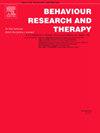Neural mechanisms underlying exposure and response prevention for obsessive compulsive disorder: A randomized controlled trial
IF 4.5
2区 心理学
Q1 PSYCHOLOGY, CLINICAL
引用次数: 0
Abstract
Background
Fear extinction is an important treatment target of obsessive-compulsive disorder (OCD). In the current randomized controlled trial, we examined the therapeutic modulation of exposure and response prevention (ERP) on neural activation during fear extinction in OCD to identify mechanisms of action and response biomarkers.
Methods
Thirty-four patients with OCD were randomized to either 12-weeks of ERP or a waitlist. Before, during, and 12-weeks after treatment, patients were assessed using functional magnetic resonance imaging (fMRI) during a 2-day fear extinction paradigm. Neural activation was examined in disease- and construct-relevant circuits and nodes (n = 18).
Results
The ERP group had a significant reduction in OCD severity compared to waitlist. A voxel-wise GLM analysis of fMRI data revealed clusters of ERP > waitlist activation during fear conditioning (bilateral dorsal amygdala and right hippocampus) and extinction (right ventrolateral prefrontal cortex, located within the salience network). These changes in activation did not correlate with OCD severity changes, however. In contrast, we observed that a reduction in the activation of the left supramarginal gyrus (in the executive control network) during extinction recall correlated with OCD symptom improvement, suggesting a possible role as a response biomarker.
Conclusions
This study highlights the relevance of a dimensional approach (e.g., focused on fear extinction) for biomarker discovery in neuropsychiatry, provides insights into the mechanisms of action of ERP in OCD, and identifies a potential treatment target in the parietal cortex that could support the biomarker-driven development of novel therapies (e.g., brain stimulation protocols), including combination treatments with ERP.
Clinicaltrials.gov identifier
NCT02467374.
强迫症暴露和反应预防的神经机制:一项随机对照试验
背景恐惧消除是强迫症(OCD)的重要治疗目标。在当前的随机对照试验中,我们研究了暴露和反应预防(ERP)对强迫症患者恐惧消退过程中神经激活的治疗调节,以确定其作用机制和反应生物标志物。方法34例强迫症患者随机分为12周ERP组和等待组。在治疗前、治疗期间和治疗后12周,在为期2天的恐惧消退范式中,使用功能磁共振成像(fMRI)对患者进行评估。在与疾病和构造相关的回路和节点中检测神经激活(n = 18)。结果与等待组相比,ERP组强迫症严重程度显著降低。对fMRI数据的体素级GLM分析显示,在恐惧调节(双侧杏仁核背侧和右侧海马)和消退(位于突出网络内的右侧腹外侧前额皮质)期间,ERP >;等待列表激活簇。然而,这些激活的变化与强迫症严重程度的变化无关。相反,我们观察到,在消失记忆过程中,左边缘上回(执行控制网络)激活的减少与强迫症症状的改善相关,这表明它可能是一种反应生物标志物。结论:本研究强调了神经精神病学生物标志物发现的维度方法(例如,专注于恐惧消退)的相关性,提供了ERP在强迫症中的作用机制的见解,并确定了顶叶皮层的潜在治疗靶点,可以支持生物标志物驱动的新疗法的开发(例如,脑刺激方案),包括与ERP的联合治疗。
本文章由计算机程序翻译,如有差异,请以英文原文为准。
求助全文
约1分钟内获得全文
求助全文
来源期刊

Behaviour Research and Therapy
PSYCHOLOGY, CLINICAL-
CiteScore
7.50
自引率
7.30%
发文量
148
期刊介绍:
The major focus of Behaviour Research and Therapy is an experimental psychopathology approach to understanding emotional and behavioral disorders and their prevention and treatment, using cognitive, behavioral, and psychophysiological (including neural) methods and models. This includes laboratory-based experimental studies with healthy, at risk and subclinical individuals that inform clinical application as well as studies with clinically severe samples. The following types of submissions are encouraged: theoretical reviews of mechanisms that contribute to psychopathology and that offer new treatment targets; tests of novel, mechanistically focused psychological interventions, especially ones that include theory-driven or experimentally-derived predictors, moderators and mediators; and innovations in dissemination and implementation of evidence-based practices into clinical practice in psychology and associated fields, especially those that target underlying mechanisms or focus on novel approaches to treatment delivery. In addition to traditional psychological disorders, the scope of the journal includes behavioural medicine (e.g., chronic pain). The journal will not consider manuscripts dealing primarily with measurement, psychometric analyses, and personality assessment.
 求助内容:
求助内容: 应助结果提醒方式:
应助结果提醒方式:


